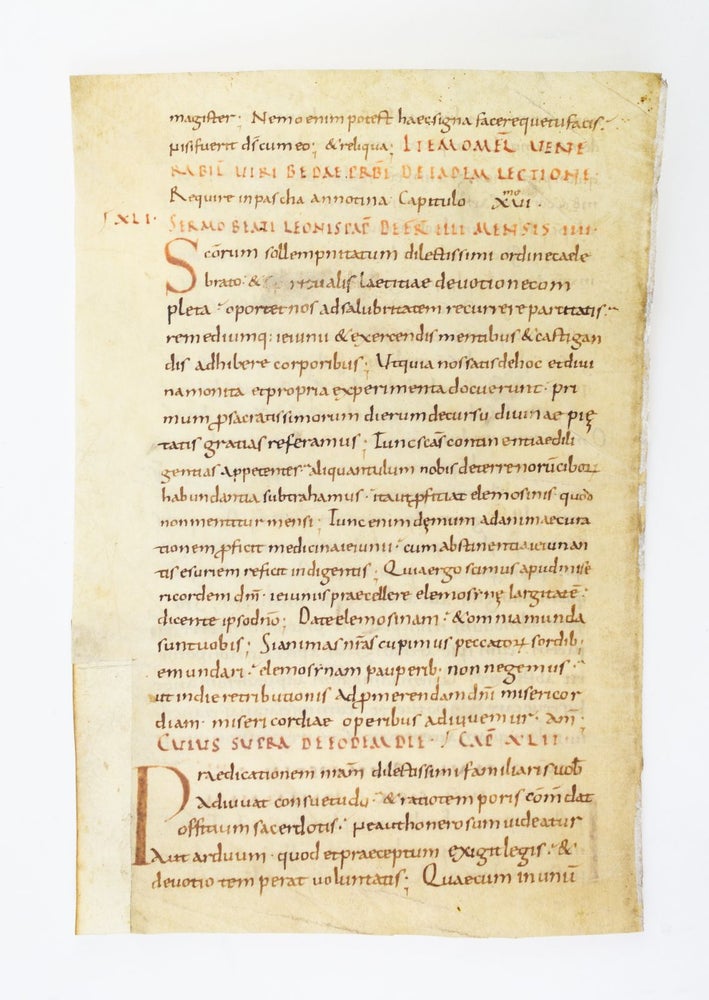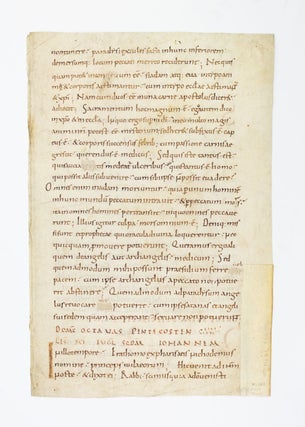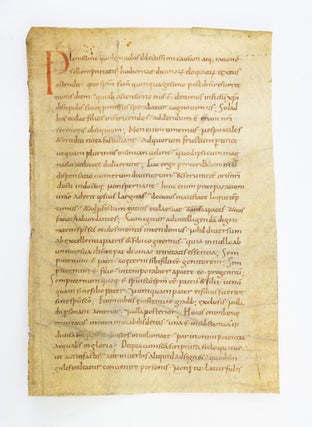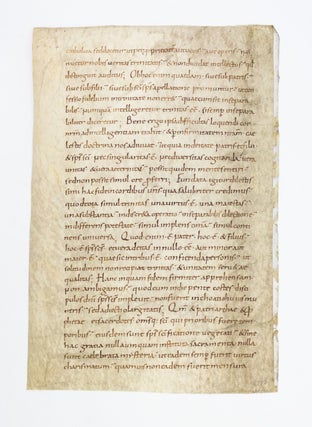PERHAPS THAT OF PAUL THE DEACON.
(Germany: second quarter of ninth century). Each leaf approximately 305 x 205 mm, (12 x 8"). Single column, 29-30 lines in a large and extremely legible Caroline minuscule.
Rubrics in red, each leaf with one or more large initials in red. Text with a few contemporary corrections and erasures. Accompanied by a copy of a letter from Bernhard Bischoff dating the manuscript leaves. ◆Vellum a little toned and soiled, one leaf with an old repair to the bottom third of the outer margin, minor folds, small stains, and other trivial imperfections, but IN EXTREMELY FINE CONDITION, the lettering clear and legible, the vellum in excellent shape, and the margins surprisingly comfortable.
These are nothing short of magnificent specimens and remarkable survivals, with wide borders all around, with entirely clear and distinct script, with only minimal overall dust soiling, and with strength and freshness to the vellum; the leaves present a powerful redolence of a time as far in the past as one could optimistically hope to encounter among Western manuscript artifacts in the marketplace. The script here is an outstanding example of the highly legible Caroline minuscule that dominated Europe in the ninth century, characterized by clear letter forms, ample spacing between letters and between lines, and very few abbreviations (the most common occurrence being "&" for "et" occurring anywhere in a word). The parent manuscript was almost certainly a Homiliary, containing sermons by various Christian authors to be said throughout the year, with the present leaves containing passages from part of Leo I, Sermo XCV, and parts of a tractatus on Luke by Ambrose, as well as other lections, readings for the Vigil of the Feast of St Peter and the Feast of the Octave of Pentecost and the opening of a sermon of Leo I for Feria IV mensis IV; four other sister leaves are known, and contain additional passages from Leo I and Ambrose, as well as Pope Gregory I and readings for various feast days. The presence of these texts suggest that the leaves might have come from a Homiliary originally composed by Paul the Deacon at the behest of Charlemagne, a version that was widely circulated throughout the Carolingian Empire in the eighth and ninth centuries. Although the scriptorium in which these leaves were produced has yet to be determined, we can say with confidence that they date to the second quarter of the ninth century due to the style of the script, as stated in the accompanying letter by esteemed paleographer Bernard Bischoff. Much of their history over the last 12 centuries remains a mystery, but we do know that three of the extant leaves were in the possession of dealer Bruce Ferrini by 1989 (with his stock number beginning "VM"), and two bear the stock numbers and price codes of Quaritch. All were acquired by Martin Schøyen and became part of the renowned Schøyen collection (MS 587). Very early leaves such as these often survive only because they come from manuscripts that were dismembered, with the leaves then being reused as binding scrap; when later recovered, they are typically in lamentable condition. The present leaves, by contrast, met no such fate--they have always been intact and untouched by the binder, and so show none of the staining and trimming that are almost always present with repurposed leaves from demolished manuscripts. This notably fine state of preservation is rarely seen on the market. As a consequence, these specimens are not only among the earliest leaves we have ever offered for sale, but also some of the most extraordinary survivals we have ever acquired. We have bought and sold only a handful of ninth century leaves in our 45 years in business; in the present case, because we were extremely lucky to acquire a small collection of six leaves from a single source, we are able to offer them here at an advantageous price point. (ST17767BE)
Price: $22,500.00




